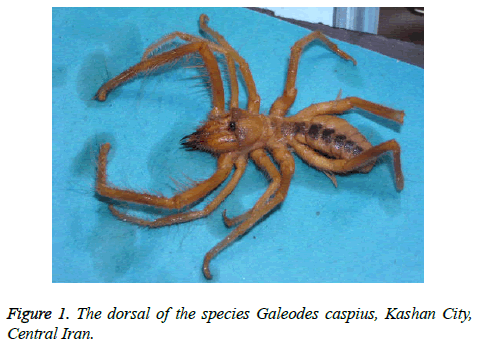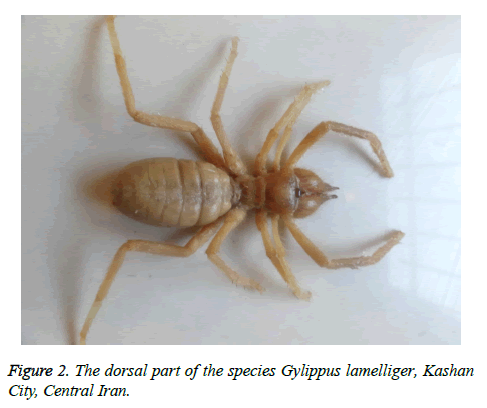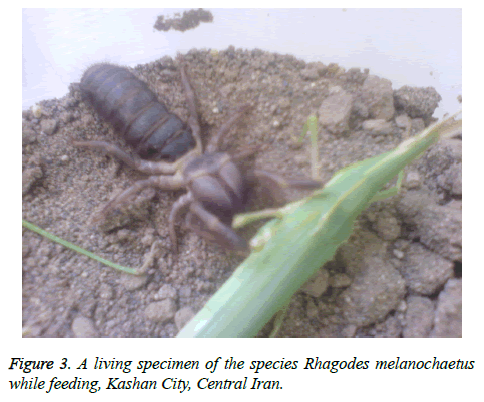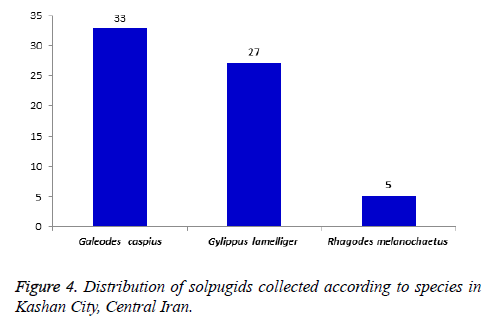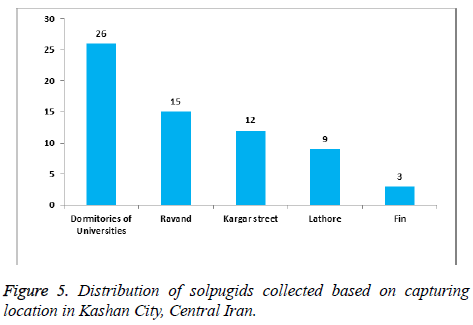ISSN: 0970-938X (Print) | 0976-1683 (Electronic)
Biomedical Research
An International Journal of Medical Sciences
Research Article - Biomedical Research (2019) Volume 30, Issue 1
A preliminary study on fauna of medical important solpugid (Chelicerata: Arachnida: Solifugae) in Kashan City, Central Iran.
Dehghani R1, Kassiri H2*, Mazaheri-Tehrani A3, Hesam M3, Yaselyani N1 and Akbarzadeh F1
1Social Determinants of Health Research Center and Department of Environmental Health, Kashan University of Medical Sciences, Kashan, Iran
2Department of Medical Entomology, School of Health, Ahvaz Jundishapur University of Medical Sciences, Ahvaz, Iran
3Deparment of Environmental Health, Hamadan University of Medical Sciences, Hamadan, Iran
- *Corresponding Author:
- Kassiri H
Department of Medical Entomology, School of Health
Ahvaz Jundishapur University of Medical Sciences, Iran
Accepted date: December 28, 2018
DOI: 10.35841/biomedicalresearch.30-18-1191
Visit for more related articles at Biomedical ResearchSolpugids are an order of hunter arthropods. They do not have poison glands or sting, but they can hunt animals larger than themselves using their powerful and large chelicerae. Due to their aggressive behavior and scary look, solpugids cause fear and horror in humans. Given the importance of solpugids in terms of causing fear, discomfort and the possibility of infection in case of biting, determining its species was noted in Kashan. This study was a descriptive research. Sixty five specimens of solpugids collected from homes and dormitories in Kashan City by hand-collecting method and were transferred to laboratory. All specimens had been collected from public and commuting places. The collected solpugids were preserved in 70% ethanol and were identified using special and valid keys under stereo-microscope in the laboratory. It was shown that at least 3 species of solpugids from Rhagodidae, Galeodidae and Gylippidae families exist in Kashan. Among 65 solpugids collected, 51% were identified Galeodes caspius, 41.5% Gylippus lamelliger and 7.5% Rhagodes melanochaetus. At least 3 species of solpugids live in 3 families in Kashan that sometimes penetrate the houses and dormitories. Thus, it is recommended that citizens be trained about the importance of these animals in ecosystem and that they know that these animals are not toxic.
Keywords
Camel spiders, Solpugid, Fauna, Frequency, Iran
Introduction
Animals to defend themselves, cause pain and suffering to their enemies by biting or injecting poison. Animals’ defense also causes fear in humans. Phobia or intense fear is a phenomenon that disrupts many people’s life consciously or unconsciously. Arachnids are an important group of arthropods that a large number of them live alongside humans. Fear of arachnids is common among different communities [1-3]. Apart from arthropods, other animals cause fear and discomfort in humans. Fear of reptiles and arthropods may be due to their being toxic or major damage to human body [4-7]. Fear of poisonous animals is a routine or common practice since some of them are poisonous and causes dangerous side effects even death in human. Scorpions are among the arthropods that have caused more damage and discomfort and death to humans compared to other poisonous biting animals in Iran and are active from north to south of the country [8-13].
Solpugids are considered among arthropods that are of great importance in ecological balance. Their bodies are composed of two parts, cephalothorax and abdomen. Also, they have powerful chelicerae that are used in tearing prey. Their size ranges from 12 to 15 cm. They have very large pedipalps that almost always are larger than the front legs. Solpugids have four pairs of legs. Most solpugids live in desert areas and tropical locations. These animals are active at night and hide in holes during the day [14,15]. Some species of them are active during the day. Their most activities have been reported from June to July [16,17]. They feed on insects and worms, scorpions, lizards and small animals. They have very large pedipalps that are very effective sensory organs and play an important role in detecting prey or food. The pedipalps of these animals have different papillae and hairs that are various in different families. They play a basic role as mechanical and chemical receptors [18,19]. Solpugids have so powerful Chelicerae that they can easily hunt preys larger than themselves. Of course, the power of each species is different from that of others. Therefore, their ability in hunting preys is different, too [20].
Solpugids contain one thousand known species and 153 genera. Only in America 196 species of them have been identified [21-23]. Solpugids live mostly in warm and dry or desert areas. They show more activity in temperate regions during spring and summer [24]. Solpugids are not dangerous and threatening and only in rare cases such as being threatened by humans, they may bite or produce voice. These animals bite, like other poisonous and nonpoisonous animals increases the risk of infection. These animals are not poisonous and only in one case, in India, it has been reported that one species of the Solpugids is poisonous and that its poison has led to the rat’s death. Of course, no other reports have been presented in confirming this report [25]. Given the importance of solpugids in terms of causing fear and discomfort and the possibility of biting humans and their abundance in tropical zones such as Kashan City; Central Iran; identification of different species of these arthropods was for the first time conducted in this region.
Materials and Methods
Kashan is located in central plateau of Iran. The main feature of this area of Iran regardless of being connected to heights and some independent domestic areas is that it has warm-dry climate and its features are cold-hard winters and hot-dry summers. Kashan region has an area of 5000 square kilometers and is located on the edge of Iran`s central desert, that is, on one side, it is surrounded by mountains and, on the other side, it borders the plains. It is 945 m above sea level with geographical coordinates of 51º east and 33º, 59" north latitude. Kashan is limited to central desert salt lake and Aran- Bidgol County to the north and to Natanz and Maymeh Counties to the south, to Kavirat region to the east, and to Delijan County in the Central Province to the west. Temperature reaches 50°C above zero in desert areas in summer and the annual rainfall on average ranges from 100 to 150 mm. In summer the sunshine raises the surface temperature of the earth up to 70°C, while at night it reduces rapidly and reaches 15°C or even lower.
This descriptive study was conducted during 2014 and 2015 and 65 specimens from 5 areas including Ravand, Fin, Lathore, dormitories of Kashan University of Medical Sciences and Islamic Azad University and Kargar street in different geographical locations of Kashan City were randomly hunted and collected by hand-collecting method. All specimens were put in the lidded container using forceps and were transferred to laboratory after registering the profile and history. The specimens were put into special bottles in 70% ethanol. Then, the solpugids were identified using special and valid keys [26-29] under stereo-microscope. Meanwhile, the specimens were also compared with the original descriptions of species. The information obtained from solpugids such as hunting location was sorted. The data were drawn using tables and so charts, then the results were compared.
Results
The results revealed that at least 3 species of solpugids from Rhagodidae, Galeodidae and Gylipidae families exist in Kashan City. Out of 65 specimens collected, 51% were from Galeodes caspius species (Figure 1), 41% Gylippus lamelliger (Figure 2) and 7.5% Rhagodes melanochaetus (Figures 3 and 4).
The highest number of solpugids, that is, almost 40% of them were collected from around the dormitories of Kashan University of Medical Sciences and Islamic Azad University that are slightly apart (Figure 5). This study only consisted of solpugids that had left their main location and habitat or place of birth to feed or do other activities. All specimens were collected after being observed or entering the residential houses or around the houses. Meanwhile, all specimens were collected from March to October. The highest abundance belonged to months from June to August.
Discussion
Results showed that three families of solpugids, that is, Rhagodidae, Galeodidae and Gylippidae exist in Kashan City. The active species of this region consist of Galeodes caspius, Gylippidae lamelliger and Rhagodes melanochaetus. This is the first documented report that has been presented about these animals. Other studies have been conducted that confirm the presence of numerous species of these animals [30-32]. This study only consisted of solpugids that had left their main habitat or birth location for the purpose of feeding or other biological activities. All specimens were collected around the residential houses or while entering the houses. It is suggested that in case of conducting a careful and active study on the main habitats of these animals, more species will be added to above-mentioned list. Researchers have reported different species of these animals in other countries such as America, Mexico, Brazil, Afghanistan, Turkey, Myanmar and India. In neighboring countries, some studies have been carried out but it seems that the study of these animals is less, compared to other animals [21-23,33-36].
Solpugids are considered predator arthropods that easily feed on different animals including scorpions and these two animals usually live in common habitats and considering the point that these animals can enter the house in the urban fringe areas and rural areas, they may cause panic and discomfort or probably bite the people [37,38]. Solpugids sometimes become aggressive and produce sounds. They may bite for self-defense. Since their chelicerae are very powerful and cause wound. Like all other bites by other animals including poisonous and non-poisonous snakes, the infection of these wounds causes infection with microbial agents of the soil or oral flora. Thus, through solpugids biting like other animals, it is possible that the wound be infected with viruses, bacteria and fungi [39-44]. The surface flora of venom injection apparatus of marine and aquatic animals in addition to poisoning can cause local or systemic infection in human. So infection is possible in human by being bitten by any animal [45,46].
People in Iran believe that when solpugids move on the ceiling, they drop themselves down and bite people through their abdomen and cause death. In some cases revenge malice are attributed to these animals and people say that this animal hides itself inside a large hole beside old wooden doors and awaiting for the body of the victim to be transferred outdoors and then the solpugids returns to its nest or after biting, it goes to the cemetery and waits for the victim. These beliefs are certainly superstitious that root in people`s ignorance or lack of awareness and does not have scientific basis [47-49].
Conclusion
Lack of awareness about the life of this animal has caused an unfounded fear of it that since the distant past has caused fear and anxiety in people. On the other hand, due to having powerful chelicerae, in case of biting they may cause deep wounds that become infected. Through training the biological characteristics and behavior, their probable losses could be presented to people. Pseudo phobia or fear of the arthropods could be reduced through attending the meetings run by experts in this field.
Acknowledgement
This study was conducted at the Social Determinants of Health Research Center and Department of Environmental Health, Kashan University of Medical Sciences, Kashan, Iran, in collaboration with the Department of Medical Entomology, School of Health, Ahvaz Jundishapur University of Medical Sciences, Ahvaz, Iran, and thanks to them. The study was approved by the Social Determinants of Health Research Center of Kashan University of Medical Sciences. The ethical principles of this research were investigated and discussed in the research committee of the above mentioned department and after making needed modifications, it was approved. The study has been done in accordance with the provisions of the Helsinki Declaration.
References
- Sabry AH, Fouad MA, Morsy AT. Entomophobia, acarophobia, parasitic dermatophobia or delusional parasitosis. J Egypt Soc Parasitol 2012; 42: 417-430.
- Hayati D, Minaei K. Investigation of entomophobia among agricultural students: the case of Shiraz University, Iran. J Entomol Acarol Res 2015; 28; 7: 43-45.
- Granado LC, Ranvaud R, Pelaez JR. A spiderless arachnophobia therapy: comparison between placebo and treatment groups and six-month follow-up study. Neur Plastic 2007.
- Dehghani R, Sharif A, Madani M, Kashani HH, Sharif MR. Factors influencing animal bites in Iran: A descriptive study. Osong Public Health Res Persp 2016; 7: 273-277.
- Dehghani R, Mehrpour O, Shahi MP, Jazayeri M, Karrari P, Keyler D, Zamani N. Epidemiology of venomous and semi-venomous snakebites (Ophidia: Viperidae, Colubridae) in the Kashan city of the Isfahan province in Central Iran. J Res Med Sci 2014; 19: 33-40.
- Dehghani R, Fathi B, Shahi MP, Jazayeri M. Ten years of snakebites in Iran. Toxicon 2014; 90: 291-298.
- Dehghani R, Arani MG. Scorpion sting prevention and treatment in ancient Iran. J Trad Compl Med 2015; 5: 75-80.
- Yousef-Mogaddam M, Dehghani R, Enayati AA, Fazeli-Dinan M, Vazirianzadeh B, Yazdani-Cherati J . Scorpion fauna (Arachnida: Scorpiones) in Darmian County, Iran (2015-2016). J Mazandaran Univ Med Sci 2017; 26: 108-118.
- Dehghani R, Fathi B. Scorpion sting in Iran: a review. Toxicon 2012; 60: 919-933.
- Dehghani R, Djadid ND, Shahbazzadeh D, Bigdelli S. Introducing Compsobuthus matthiesseni (Birula, 1905) scorpion as one of the major stinging scorpions in Khuzestan, Iran. Toxicon 2009; 54: 272-275.
- Shahbazzadeh D, Amirkhani A, Djadid ND, Bigdeli S, Akbari A, Ahari H, Amini H, Dehghani R. Epidemiological and clinical survey of scorpionism in Khuzestan province, Iran (2003). Toxicon 2009; 53: 454-459.
- Yousef Mogaddam M, Dehghani R, Enayati AA, Fazeli-Dinan M, Motevalli Haghi F. Epidemiology of scorpionism in Darmian, Iran, 2015. J Mazandaran Univ Med Sci 2016; 26: 131-136.
- Ghafourian M, Ganjalikhanhakemi N, Hemmati AA, Dehghani R, Kooti W. The Effect of Hemiscorpius lepturus (Scorpionida: Hemiscorpiidae) venom on leukocytes and the leukocyte subgroups in peripheral blood of rat. J Arthropod-Borne Dis 2016; 10: 159-167.
- Muma MH. Comparison of three methods for estimating solpugid (Arachnida) populations. J Arachnol 1980; 1: 267-270.
- Wharton RA. Biology of the diurnal Metasolpuga picta (Kraepelin) (Solifugae, Solpugidae) compared with that of nocturnal species. J Arachnol 1986; 1: 363-383.
- Martins EG, Bonato V, Machado G, Pinto-da-Rocha R, Rocha LS. Description and ecology of a new species of sun spider (Arachnida: Solifugae) from the Brazilian Cerrado. J Nat History 2004; 38: 2361-2375.
- Xavier E, Rocha LS. Autoecology and description of Mummucia mauryi (Solifugae, Mummuciidae), a new solifuge from Brazilian semi-arid Caatinga. J Arachnol 2001; 29: 127-134.
- Cushing PE, Casto P, Knowlton ED, Royer S, Laudier D, Gaffin DD, Prendini L, Brookhart JO. Comparative morphology and functional significance of setae called papillae on the pedipalps of male camel spiders (Arachnida: Solifugae). Ann Entomol Soc Am 2014; 107: 510-520.
- Cushing PE, Casto P. Preliminary survey of the setal and sensory structures on the pedipalps of camel spiders (Arachnida: Solifugae). J Arachnol 2012; 40: 123-127.
- Van der Meijden A, Langer F, Boistel R, Vagovic P, Heethoff M. Functional morphology and bite performance of raptorial chelicerae of camel spiders (Solifugae). J Exp Biol 2012; 215: 3411-3418.
- Harvey MS. The neglected cousins: what do we know about the smaller arachnid orders? J Arachnol 2002; 30: 357-372.
- Brookhart JO, Brookhart IP. An annotated checklist of continental North American Solifugae with type depositories, abundance, and notes on their zoogeography. J Arachnol 2006; 34: 299-330.
- Ballesteros JA, Francke OF. A new species of sun-spider from sand dunes in Coahuila, Mexico (Arachnida: Solifugae: Eremobatidae). Zootaxa 2008; 1665: 61-68.
- Catenazzi A, Brookhart JO, Cushing PE. Natural history of coastal Peruvian solifuges with a redescription of Chinchippus peruvianus and an additional new species (Arachnida, Solifugae, Ammotrechidae). J Arachnol 2009; 37: 151-159.
- Aruchami M, Sundara Rajulu G. An investigation on the poison glands and the nature of the venom of Rhagodes nigrocinctus (Solifugae: Arachnida). Nat Acad Sci Lett (India) 1978; 1: 191-192.
- Birula AA. Bemerkungen über die Ordnung der Solifugen. I-V. Annuaire Mus Zool Acad Sci St. Petersbourg 1905: 391-416.
- Birula AA. Arachnides, Ordo Solifuga. Moscow and Leningrad: Academie des Sciences de lURSS 1938; 1:1-173.
- Roewer CFS, Palpigradi. Leipzig, Germany: Akademische Verlagsgesellscha M.B.H. 1933; 161-480.
- Roewer CF. Solifugae, Palpigradi. Akademische Verlagsgesellscha M.B.H. 1934; 481-723.
- Maddahi H, Kami HG, Aliabadian M, Mirshamsi O. Redescription of Rhagodes eylandti (Walter, 1889) (Arachnida: Solifugae) with notes on its morphological variation and geographic distribution. Zool Mid East 2015; 61: 278-284.
- Maddahi H, Khazanehdari M, Aliabadian M, Kami HG, Mirshamsi A, Mirshamsi O. Mitochondrial DNA phylogeny of camel spiders (Arachnida: Solifugae) from Iran. Mitochondrial DNA A DNA Mapp Seq Anal 2017; 28: 909-919.
- Khazanehdari M, Mirshamsi O, Aliabadian M. Contribution to the solpugid (Arachnida: Solifugae) fauna of Iran. Turk J Zool 2016; 40: 608-614.
- Gromov AV. Solpugids of the genus Eusimonia Kraepelin, 1899 (Arachnida: Solifugae, Karschiidae) of Central Asia. Ekol Bratislava 2000; 19: 79-86.
- Halil KO. New record of Gylippus (Paragylippus) monoceros Werner, 1905 (Solifugae: Gylippidae) in Western Anatolia, Turkey. Biharean Biologist 2011; 5: 119-122.
- Pandram B, Sharma VK. The first report of the Solifugae (family: Galeodidae, Sundvell 1833) from Madhya Pradesh, India. J Entomol Zool Studies 2015; 3: 75-77.
- Karatas A, Munir UX. A new Barrussus Roewer, 1928 (Solifugae: Karschiidae) from southern Turkey. Turk J Zool 2013; 37: 594-600.
- Dehghani R, Valizade R, Mahmoodi S. A review of the scorpion predators and the introduction of Scarites subterraneus, as a new predatory of them in Iran. J Entomol Res 2016; 40: 291-296.
- Dehghani R, Khamehchian T, Miranzadeh MB. Surveying on the biologic behaviors of Hemiscorpius lepturus (Peters, 1861) scorpion in laboratory (Khuzestan, Iran) (Scorpions: Hemiscorpiidae). Pak J Biol Sci 2007; 10: 3097-3102.
- Dehghani R, Reza Sharif MR, Moniri R, Sharif A, Haddad Kashani H. The identification of bacterial flora in oral cavity of snakes. Comp Clin Pathol 2016; 25: 279-283.
- Dehghani R, Sharif A, Assadi MA, Haddad Kashani H, Sharif MR. Fungal flora in the mouth of venomous and non-venomous snakes. Comp Clin Pathol 2016; 25: 1207-1211.
- Dehghani R, Rastegar pouyani N, Dadpour B, Keyler D, Panjehshahi M, Jazayeri M, Omid Mehrpour, Habibi Tamijani A. A survey on non-venomous Snakes in Kashan (Central Iran). J Biol Todays World 2016; 5: 65-75.
- Huang LW, Wang JD, Huang JA, Hu SY, Wang LM, Tsan YT. Wound infections secondary to snakebite in central Taiwan. J Venom Anim Toxins Trop Dis 2012; 18; 272-276.
- Dehghani R, Kassiri H, Gharali B, Hoseindoost G, Chimehi E. Introducing of a new sting agent of velvet ant Dentilla sp. (Hymenoptera: Mutillidae) in Kashan, Centerl of Iran (2014-2015). Arch Clin Infect Dis Online 2018.
- Dehghani R, Kamiabi F, Mohammadi M, Scorpionism by Hemiscorpius spp. in Iran: a review. J Venom Animals Toxins Trop Dis 2018; 24: 8.
- Babalola MO, Balogun JA. The ecology and potential health risk of the oral microflora of Python regius and Clelia scyn-talina. Int J Microbiol Res 2013; 5: 349-356.
- Dehghani R, Kamiabi F, Kassiri H, Hashemi A, Mohammadzadeh N, Gharagazloo F. A Study on litter size in several important medical scorpions species (Arachnida: Scorpionida), Iran. J Entomol 2018; 15: 155-160.
- Firoozfar F, Norjah N, Baniardalani M, Moosa-Kazemi H. Knowledge, attitudes and practices study in relation to entomophobia and its application in vector-borne-diseases. Asian Pacific J Trop Biomed 2012; 1135-1137.
- Swan JA, Hyland PH. A review of the beneficial mental health effects of exercise and recommendations for future research. Psychol Soc 2012; 5: 1-5.
- Dehghani R. Solpugidophobia in Iran: real or illusion. J Biol Todays World 2017; 6: 46-48.
